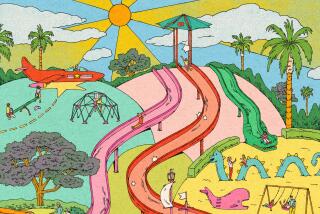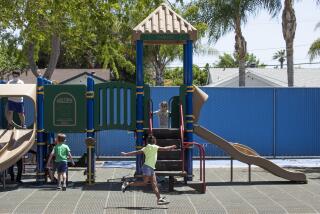SANTA ANA : Park Removes Barriers That Keep Disabled Kids From Having Fun
- Share via
Dressed in shorts and sandals, Mayra Reyes looked like a typical 8-year-old as she waited her turn at the playground Thursday.
But Mayra, a third-grader at Harvey Elementary School, uses a wheelchair, and the playground she was about to enter was specifically built to accommodate children like herself.
Mayra was one of about 200 youngsters, many of them disabled, who attended the opening of the Carl Thornton barrier-free playground, the first of its kind in Santa Ana and probably the largest of its kind in the county once it is completed.
Amenities include an oversized swing with handles at the side, which allows children in wheelchairs to pull themselves onto the seat. Instead of sand, there is a rubber platform below the swing.
Mayra, who was being wheeled around the conglomeration of slides and swing sets, said her favorite part was an elevated sand pit, which allows children who cannot leave their wheelchairs to do things such as make sand castles.
Simply put, “It’s good because there are lots of games,” Mayra said of the playground on West Segerstrom Avenue.
The one-acre park also is open to children who are not disabled. Suzi Furjanic, an assistant park planner with the city of Santa Ana, said an effort was made to ensure that disabled children and others could play side by side.
About nine years ago, the Kiwanis Club of Santa Ana broached the idea of a park that would accommodate disabled children, and since then, the club has worked with the city to finance and plan the project.
This first phase of the park that opened Thursday cost $480,000 to build. The next two phases, which will include an overnight campground and modified basketball court with lowered baskets, will cost an additional $2 million.
The Kiwanis contributed $30,000 to phase one, and the rest of the money came from the city and county. The next two phases also will be built with a combination of public and private money.
Phase two is expected to be completed by 1997, and phase three by the year 2000. When completed, the barrier-free play area will take up 2 1/2 acres of the 30-acre park.
More to Read
Sign up for Essential California
The most important California stories and recommendations in your inbox every morning.
You may occasionally receive promotional content from the Los Angeles Times.













